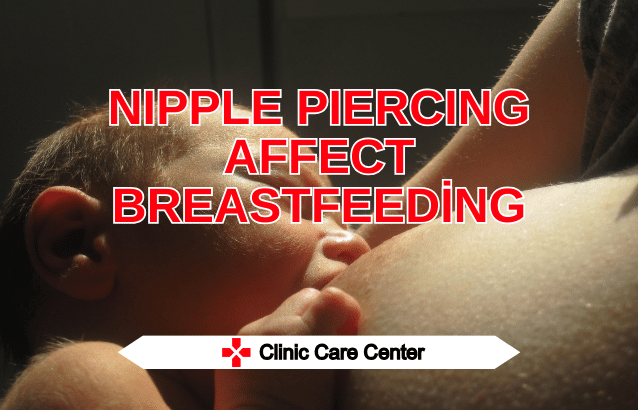The impact of scar tissue from a nipple piercing on breastfeeding depends on the severity and location of the scar. Here’s a breakdown:
Minimal impact:
- Limited scar tissue: If the scar tissue is minimal and doesn’t directly affect the milk ducts, it’s unlikely to significantly impact breastfeeding. The human nipple typically has 8-12 milk duct openings, so one slightly blocked duct shouldn’t cause major problems.
- Proper piercing placement: Nipple piercings placed correctly in the non-lactating tissue (avoiding the milk ducts) are less likely to cause issues with breastfeeding.
Potential impact:
- Extensive scar tissue: If the scar tissue is extensive and blocks several milk ducts, it can reduce milk flow and potentially lead to low milk supply. This can make breastfeeding more challenging or even impossible.
- Scar tissue location: Scars located directly over the milk ducts or near the nipple tip are more likely to interfere with breastfeeding than scars further away.
Other factors:
- Piercing material: Certain types of jewelry material, like nickel, can irritate the nipple and worsen scar tissue formation.
- Hygiene: Maintaining good hygiene and avoiding infections can help minimize scar tissue development.
Here are some additional points to consider:
- Wait for healing: It’s crucial to wait until the piercing is fully healed (around 3-4 months) before attempting to breastfeed. This reduces the risk of infection and allows the scar tissue to stabilize.
- Consult with a lactation consultant: If you have concerns about scar tissue impacting your breastfeeding, consult with a lactation consultant. They can assess your situation and offer personalized advice or suggest alternative breastfeeding techniques.
- Remove jewelry while breastfeeding: Remove the jewelry from your piercing before each breastfeeding session. This prevents the risk of choking for the baby and allows easier access to the nipple.
In conclusion, while scar tissue from a nipple piercing has the potential to affect breastfeeding, the severity of the impact depends on various factors. Consulting with a healthcare professional or lactation consultant can help you determine if your scar tissue is likely to cause problems and offer guidance on safe and successful breastfeeding.

Can you breastfeed if you get nipple piercings?
Yes, it is generally possible to breastfeed with nipple piercings, but there are some important things to consider:
Safety:
- Wait for healing: It’s crucial to wait until the piercing is fully healed before attempting to breastfeed. This usually takes around 3-4 months.
- Proper hygiene: Maintain good hygiene to prevent infections, which can be harmful to your baby and worsen scar tissue formation.
- Remove jewelry: Jewelry should be removed before each breastfeeding session to prevent choking hazards for the baby and ensure proper latch.
- Observe your baby: Monitor your baby for any signs of discomfort or difficulty latching due to the piercing.
Potential challenges:
- Scar tissue: Extensive scar tissue from the piercing might block milk ducts, causing low milk supply and making breastfeeding difficult.
- Pain: The piercing may be sensitive during breastfeeding, especially in the initial stages.
- Latch issues: The piercing might interfere with your baby’s latch, leading to frustration for both of you.
Here are some tips for successful breastfeeding with nipple piercings:
- Choose a reputable piercer: Ensure the piercer uses sterile equipment and follows proper hygiene protocols.
- Select the right jewelry: Opt for biocompatible materials like titanium or gold to minimize irritation.
- Start slowly: Introduce the baby to the nipple gradually, allowing them to adjust to the sensation.
- Use different positions: Experiment with different breastfeeding positions to find one that feels comfortable for you and your baby.
- Seek professional help: If you encounter any difficulties or concerns, consult with a lactation consultant.
Ultimately, the decision to breastfeed with nipple piercings is a personal one. Weigh the potential benefits and risks carefully and seek advice from healthcare professionals if needed.
What other problems can nipple piercings cause while breastfeeding?
Besides the potential for scar tissue and choking hazards, nipple piercings can also cause other problems while breastfeeding, including:
Pain and discomfort: The piercing may be sensitive during breastfeeding, especially while your baby is latching on. This can lead to discomfort and pain for the mother, which can make breastfeeding difficult and less enjoyable.
Mastitis: Mastitis is an inflammation of the breast tissue, often caused by a bacterial infection. Breastfeeding with nipple piercings can increase the risk of mastitis due to the potential for bacteria to enter the breast through the piercing hole.
Blocked milk ducts: The jewelry used in nipple piercings may put pressure on the milk ducts, blocking them and preventing milk flow. This can lead to engorgement, pain, and decreased milk supply.
Rejection: In some cases, the body may reject the nipple piercing, causing the jewelry to push out through the skin. This can be painful and lead to scarring.
Infections: Although rare, infections can occur at the piercing site. These can be painful and require medical treatment with antibiotics.
Baby’s oral health: If the baby bites or chews on the nipple piercing, it can cause damage to the jewelry and potentially injure the baby’s mouth.
Psychological factors: Some mothers may feel self-conscious or uncomfortable breastfeeding with nipple piercings, which can impact their overall breastfeeding experience.

Nipple piercings are a popular body modification, but concerns arise about their safety during pregnancy and breastfeeding. While possible, it’s crucial to consider potential risks and take precautions.
Pregnancy:
Risks:
- Metal migration: Jewelry material like nickel can migrate into surrounding tissue, causing irritation and allergic reactions.
- Scarring: Pregnancy hormones can worsen existing scar tissue or lead to new scarring around the piercing.
- Increased sensitivity: The piercing may become more sensitive and painful due to increased blood flow and nipple changes.
- Hygiene challenges: Maintaining hygiene around the piercing can become more difficult with a growing belly.
Precautions:
- Choose biocompatible jewelry: Opt for materials like titanium or gold to minimize irritation and migration risks.
- Maintain good hygiene: Regularly clean the piercing with sterile saline solution.
- Monitor for changes: Observe any pain, redness, swelling, or discharge around the piercing.
- Consult healthcare professionals: Discuss concerns with your doctor or midwife.
Breastfeeding:
Risks:
- Blocked milk ducts: Jewelry pressure can restrict milk flow, leading to engorgement and decreased supply.
- Mastitis: Increased risk of bacterial infection due to potential entry through the piercing hole.
- Pain and discomfort: Breastfeeding can be painful, especially during latching, due to the piercing.
- Baby’s oral health: The baby might bite or chew on the jewelry, causing injury.
- Impact on latch: The piercing might interfere with the baby’s ability to latch properly.
Precautions:
- Remove jewelry before breastfeeding: This reduces choking hazards and allows easier latching.
- Start slowly: Introduce the baby to the pierced nipple gradually.
- Experiment with positions: Find breastfeeding positions comfortable for both you and your baby.
- Monitor baby’s feeding: Observe any difficulties or discomfort during breastfeeding.
- Seek professional help: Consult a lactation consultant for challenges with latch or milk flow.
General Recommendations:
- Wait for full healing: Avoid getting pregnant or breastfeeding until the piercing is fully healed (3-4 months).
- Choose a reputable piercer: Ensure they use sterile equipment and follow proper hygiene protocols.
- Listen to your body: Pay attention to any pain or discomfort and stop breastfeeding if necessary.
- Communicate openly: Discuss your concerns and preferences with your healthcare providers.
Ultimately, the decision to get nipple piercings and breastfeed is personal. Weigh the potential benefits and risks carefully and prioritize baby’s safety and well-being. Consulting with healthcare professionals and lactation consultants can provide valuable guidance and support throughout pregnancy and breastfeeding.
